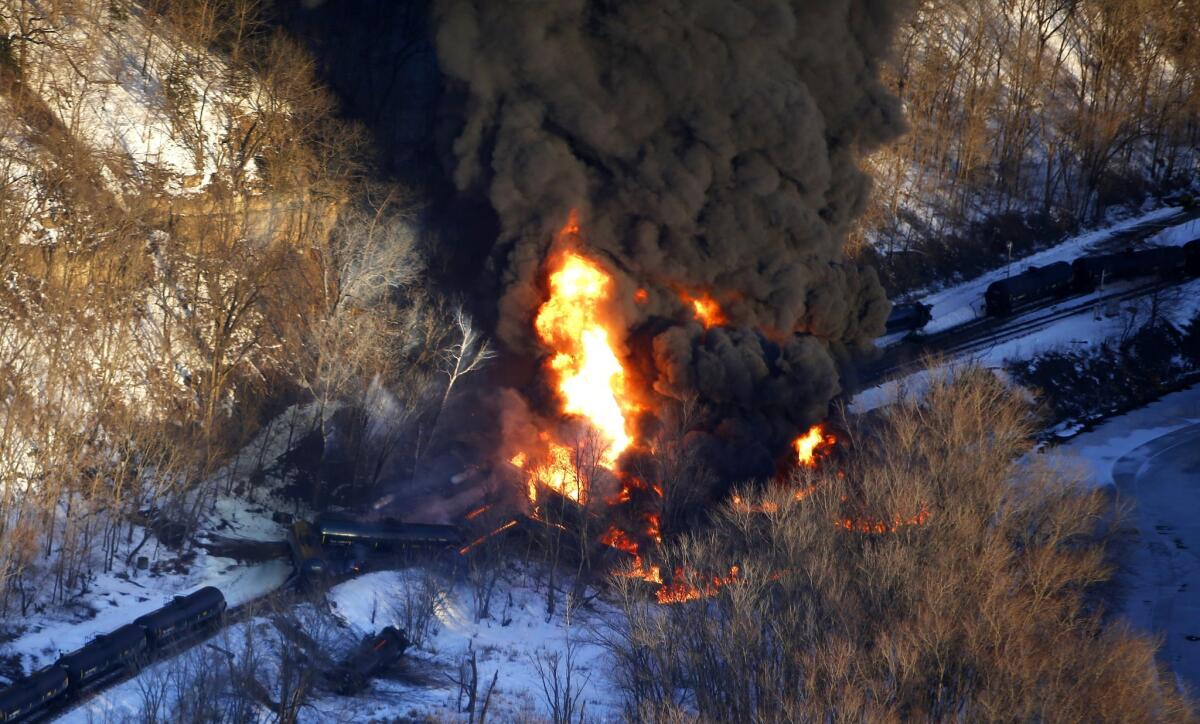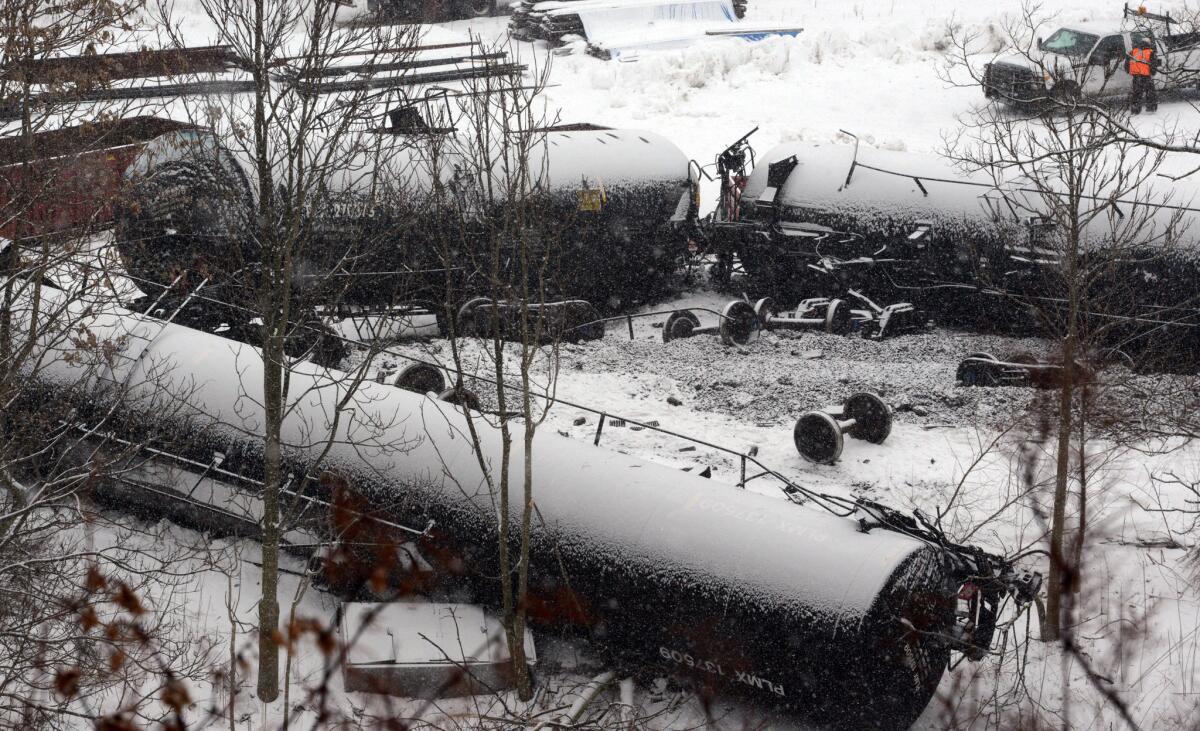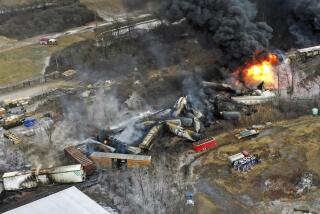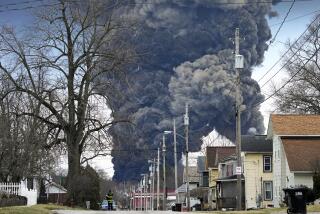Why are so many oil trains crashing? Track problems may be to blame

Smoke and flames erupt from the scene of a train derailment March 5, 2015, near Galena, Ill. A BNSF Railway freight train loaded with crude oil derailed in a rural area where the Galena River meets the Mississippi.
The only sign of trouble aboard a Norfolk Southern train, hauling roughly 9,000 tons of Canadian crude in western Pennsylvania last year, was a moderate sway in the locomotive as it entered a bend on the Kiskiminetas River.
The first 66 cars had passed safely around the curve when the emergency brakes suddenly engaged, slamming the train to a stop. The conductor trudged back nearly a mile through newly fallen snow to see what happened.
Twenty-one cars had derailed, one slamming through the wall of a nearby factory. Four tank cars were punctured, sending 4,300 gallons of crude pouring out of the tangled wreckage.

Cars are seen from a freight train derailment on Feb. 13, 2014, in Vandergrift, Pa.
The cause of the accident in North Vandergrift was identified as a failure in the rails — not aging or poorly maintained tracks, but a relatively new section laid less than a year earlier.
The February 2014 crash fits into an alarming pattern across North America that helps explain the significant rise of derailments involving oil-hauling trains over the last three years, even as railroads are investing billions of dollars in improving the safety of their networks. A review of 31 crashes that have occurred on oil trains since 2013 puts track failure at the heart of the growing safety problem.
Track problems were blamed on 59% of the crashes, more than double the overall rate for freight train accidents, according to a Times analysis of accident reports. Investigators and rail safety experts are looking at how the weight and movements of oil trains may be causing higher than expected track failures.
The growing number of trains hauling crude oil from Canada and the Northern Plains are among the heaviest on the rails today, many extending more than 100 cars in length and weighing a cumulative 19,000 tons or more.
Not since the early days of John D. Rockefeller’s oil trust have railroads played such a central role in moving oil from wells to refineries. Oil shipments by rail have soared — an 18-fold increase between 2010 and 2014 — as domestic oil production has escalated faster than the construction of new pipelines to carry it to market.
Concerns about the safety of hauling crude began to rise after the horrific Lac-Megantic accident in Quebec in July 2013 that left 47 people dead and the city’s downtown in ruins.
The Federal Railroad Administration is preparing in coming weeks to issue a new set of initiatives to address the track problems, after previously clamping tighter restrictions on tank car designs and railroad operations. But solving the track problems could be a formidable challenge.
Sarah Feinberg, chief of the Federal Railroad Administration, said the agency is working hard to improve safety, but preventing accidents that result from defective track involves finding a needle in every haystack along thousands of miles of track.
“We have been incredibly lucky that the accidents have happened mostly in rural areas,” she said. “Some of them have been very close calls.”
The crashes have occurred as the nation’s railroad system is being asked to do more than at any time in history, putting additional wear and tear on the tracks. Since 2001, railroads have seen a modest 12% increase in the number of cars they haul, but a 24% jump in the more comprehensive measurement of cargo that looks at the weight and train mileage the system has to bear, known as ton-miles, according to industry data.
Though railroads have significantly improved safety in general, the oil train accidents are a worrisome trend in the opposite direction and not fully understood.
NEWSLETTER: Get the day’s top headlines from Times Editor Davan Maharaj >>
Of the 31 crashes involving crude or ethanol since 2013, 17 were related to track problems and 12 a mix of other causes. The cause of the two other crashes remains unclear. The count is based on both final or preliminary government and railroad investigations that were collected by The Times under the Freedom of Information Act or in U.S., Canadian and railroad company filings.
About two-thirds of the accidents resulted in spills, fires or explosions, a record that has already prompted regulators to demand stronger tank cars and other safety measures.
Weight, oil sloshing and cold temperatures are among the issues that might be exacerbating the problem, according to rail safety experts.
Investigators at Safety Transportation Board Canada, which is investigating the eight accidents that have occurred in that country, are beginning to suspect that the oil trains are causing unusual track damage.
“Petroleum crude oil unit trains transporting heavily loaded tank cars will tend to impart higher than usual forces to the track infrastructure during their operation,” the safety board said in a report this year. “These higher forces expose any weaknesses that may be present in the track structure, making the track more susceptible to failure.”
Rick Inclima, safety director at the Brotherhood of Maintenance of Way Employees, also said that oil trains could be creating unique stresses on the track. “You can certainly get some rhythmic forces in ... oil trains that you might not see on a mixed freight train with cars of different sizes, weights and commodities,” he said.
The nation’s major railroads are investing record amounts of money to upgrade their tracks and improve safety. The seven class-one railroads, which haul the majority of the nation’s freight, are spending $29 billion this year on their systems, nearly double the level of 2001, according to the American Assn. of Railroads. The trade group did not have any response to The Times analysis of oil train accidents, though it said its member companies exceed federal requirements for inspection and safety.
But that has not eliminated the problem. While all types of derailments dropped 17% over the last three years, there are still more than three every day across the nation, involving trains carrying a variety of freight, according to federal safety data. Bad track accounts for about 27% of overall accidents, less than half the rate that track problems are contributing to oil train accidents.
Though railroad technology may seem antiquated in a digital age, it relies on incredible precision to control monstrously heavy loads. The track in North Vandergrift, Pa., where the Norfolk Southern accident occurred, carries about 30 million tons of freight every year.
The relentless pounding plays havoc with any metallurgical flaw. Wooden ties deteriorate as they age. And other track components crack.
Investigators attributed the Pennsylvania derailment to a “wide gauge” failure, in which the rails were pushed too far apart to keep the wheels on the tracks.
The freight tracks in the U.S. and most of the world are supposed to be 56.5 inches apart, a width known as the gauge. Just three inches of movement can cause a derailment. And even if tracks conform to federal standards, they can separate under the force of a heavy train.
“Wide gauge” is the single largest cause of accidents involving track defects. In the case of the Pennsylvania derailment, it was broken spikes that caused the rail to widen, even though the track had been replaced in 2012, according to Federal Railroad Administration officials.
Private railroad experts have suggested that the sloshing of oil inside the cars may also be involved in the derailments.
Tank cars are only partially filled with oil, allowing for expansion if the temperature increases. The tanks have internal baffles, but the liquid can still slosh as the cars move, causing higher dynamic loads, said Bill Keppen, an independent rail safety expert. “Sloshing increases the stress on the track,” he said.
Federal safety experts said if sloshing does have an effect, they do not consider it significant.
The Times examination of accident reports also shows the large majority of derailments occurred in below freezing temperatures, ranging down to 23 below zero in a crash this year in Ontario.
As temperatures drop, steel rails progressively shrink, amplifying the potential for any existing defect to cause a failure, FRA safety experts said in interviews. Frozen ballast, the crushed rock that forms the rail bed, also causes rail to undergo greater shocks under the load of heavy trains.
Federal regulators and the industry are trying to improve safety, but opinions are sharply divided about exactly what measures are needed.
The Federal Railroad Administration, for example, has ordered that crude-carrying trains can travel at no more than 40 miles per hour in urban areas. But the North Vandergrift train was going only 36 mph. Nineteen of the trains whose speeds are known were moving 40 mph or slower, and no train was going faster than 50 mph, records show.
The railroad administration has increased its track inspections and railroads have agreed to increase their own inspections, according to Matthew Lehner, the agency’s communications director.
“In the coming weeks, the Federal Railroad Administration plans to announce additional steps to prevent crude oil train derailments,” Lehner said.
Critics say that many of the safety initiatives adopted so far reflect a policy aimed at mitigating the damage caused by derailments rather than preventing them.
“The attention has changed,” said Brigham McCown, former chief of the federal agency that sets tank car standards. “I hear people say, ‘It happens, they derail.’ I think that is an untenable position. As a safety regulator, I don’t think you can ever say, ‘Things blow up,’ or ‘Things crash.’ I believe the Department of Transportation has myopically focused on incident mitigation. Prevention should be the first question they should address.”
ALSO
Agency targets the fine print preventing customers from joining class actions
Obama seeks backing from both parties for Pacific Rim trade deal
Gov. Jerry Brown approves new limits on paparazzi drones
More to Read
Sign up for Essential California
The most important California stories and recommendations in your inbox every morning.
You may occasionally receive promotional content from the Los Angeles Times.











